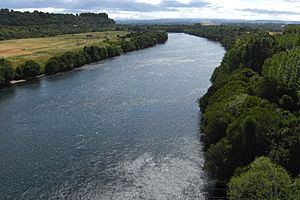Battle of Río Bueno (1654) facts for kids
Quick facts for kids Battle of Río Bueno |
|||||||
|---|---|---|---|---|---|---|---|
| Part of Arauco War | |||||||
|
|||||||
| Belligerents | |||||||
|
Mapuche-Huilliche |
|||||||
| Commanders and leaders | |||||||
| Strength | |||||||
| 900 Spanish soldiers 1500 Indian auxiliaries |
3000 Mapuche-Huilliches | ||||||
| Casualties and losses | |||||||
| About 100 soldiers lost 200 auxiliaries lost |
Few | ||||||
The Battle of Río Bueno (Spanish: Batalla de Río Bueno) was an important fight in 1654. It happened in what is now southern Chile. The battle was between the Spanish Army and the native Cuncos and Huilliches from the area called Fütawillimapu.
This battle was part of a much longer conflict called the Arauco War. The Cuncos and Spanish had been in conflict for a long time. This goes back to when the city of Osorno was destroyed in 1603. A more recent reason for the battle was a disagreement over a Spanish shipwreck. The Cuncos took goods from the ship. The Spanish wanted to punish them and also hoped to capture people to make them slaves.
Some people, including Jesuit priests, tried to stop the war. But a Spanish military leader named Juan de Salazar convinced the Governor of Chile, Antonio de Acuña Cabrera, to let him lead an expedition. The battle took place at the Bueno River. The Cuncos and Huilliches stopped the Spanish from crossing the river. Hundreds of Spanish soldiers drowned or were killed. This defeat helped start the Mapuche uprising of 1655. During this uprising, many Spanish towns and farms were attacked.
The Battle of Río Bueno and the events that followed caused a big problem for the Spanish in Chile. It almost led to a civil war among them. This crisis was so serious that some historians believe it was one of the early reasons for Chile's independence much later. The Cuncos and Huilliches south of the Bueno River stayed independent until the late 1700s.
The Battle Begins
The Spanish army started its journey from a fort called Nacimento. This fort was in an area known as La Frontera. The army had about 900 Spanish soldiers. They also had 1500 native helpers, called auxiliaries.
On January 11, 1654, the Spanish reached the northern side of the Bueno River. This river flows from east to west. To get across, Salazar ordered his men to build a special floating bridge. The local Mapuche-Huilliche people knew the Spanish were coming. So, they gathered in large numbers on the other side of the river.
The Mapuche-Huilliche had brought their families with them. But the women and children stayed hidden in the forest. Most of the men also stayed hidden. Only the men on horseback showed themselves to the Spanish. In total, there were about 3000 Mapuche-Huilliche fighters. They mainly used long spears as their weapons.
Crossing the River
Some experienced Spanish officers had doubts about Salazar's plan. They worried if the bridge would be strong enough. Once the floating bridge was ready, Juan de Salazar sent the first group of soldiers across. About 200 soldiers crossed the river. But they were quickly surrounded by the Mapuche-Huilliche. They were being defeated.
Salazar then told the other soldiers to hurry across the bridge. However, the bridge was not strong enough. It broke apart at this moment. This caused a huge disaster for the Spanish army. In total, the Spanish lost about 100 professional soldiers. They also lost 200 of their native helpers. The actual fighting in this battle was very limited. Despite these losses, the Spanish who survived managed to get back north. The Mapuche did not chase them.
What Happened Next
When the governor, Acuña Cabrera, heard about the defeat, he ordered an investigation. He wanted to find out if anyone in the military had done something wrong during the campaign. However, Salazar's sister, Juana de Salazar, was married to the governor. She made sure that witnesses would say her brother had done nothing wrong.
The investigation decided that Juan de Salazar should lead an even bigger army. This new army would punish the Cuncos. It would also allow Salazar to get back his good name, or honour.
The plans for this second expedition were made in the summer of 1655. These plans helped to start a large Mapuche uprising that same year.


